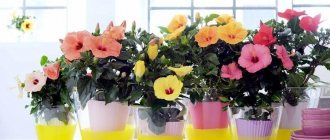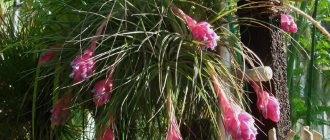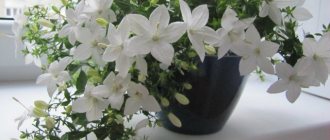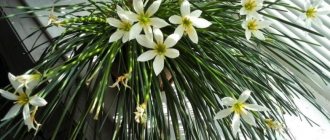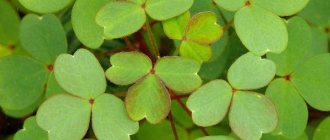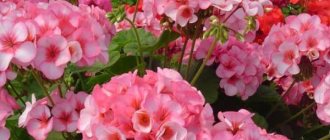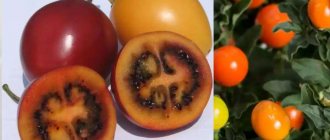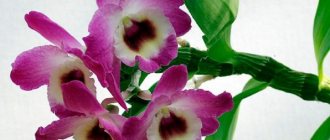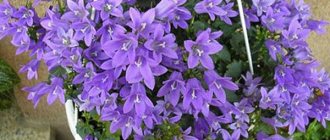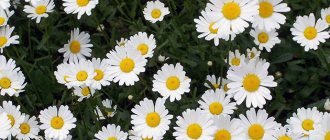Iresine (lat. Iresine) is a genus of plants from the Amaranth family (lat. Amaranthacea). They are highly prized for their beauty and are grown in gardens and at home. However, people call irezine “beefsteak”, “chicken stomach”, “bloody leaf”, which is due to its unusual color. Although representatives of the genus are heat-loving and their native environment is the tropics, with proper care they feel good in the countries of the Northern Hemisphere. The Agronom.guru portal will tell you in detail about all the features and properties of the plant.
Irezine
Botanical description
Most irezine plants are herbaceous annuals or perennials. The smaller part is climbing or free-standing subshrubs or shrubs.
The aerial parts are smooth or covered with hairs, usually completely or partially red in color, which gives them the pigment betacyanin.
The alternate or opposite leaves are divided into petioles and simple blades. They can be entire or jagged.
Plants are mostly dioecious. Many small, inconspicuous flowers are collected in lateral capitate or terminal paniculate, complex and open inflorescences.
Bracts leathery, shiny. Five petals are free or fused at the base.
The fruits are globose to flattened, containing only one seed, dark red to reddish brown in color, and lenticular to kidney shaped.
Irezine - shrub or subshrub
Transfer
If irezine is grown as an annual plant, replanting is not required. The perennial needs to be replanted every 2–3 years, when the root system does not have enough space in the flowerpot.
Also, replanting is required 2 weeks after purchase, in case of rotting of the roots or if the plant is damaged by pests.
The plant has thin and delicate roots, so replanting must be done using the transshipment method.
- prepare drainage and a new pot of slightly larger volume;
- pour a layer of drainage and soil onto the bottom of the flowerpot;
- lightly crush the old flowerpot, turn it over and, holding the plant with your hands, remove it along with the earthen lump;
- place the irezine in the center of the new container, preserving the old earthen lump;
- pour new soil into the flowerpot, filling the voids and compact it slightly, but do not compact it.
After transplantation, the plant requires abundant watering and spraying.
Prevalence
The natural distribution area covers tropical Asia, western Africa, tropical and subtropical regions of North and South America, and the Pacific Islands, including the Galapagos.
origin of name
The etymological root of the binomial name Iresine is presumably derived from the Greek word eiros, meaning “wool”, since iresine has pubescent seeds. The genus was first described by the Irish botanist and physician Patrick Brown in his work The Civil and Natural History of Jamaica.
Irezine is a beautiful and unpretentious plant for your home or garden
Iresine is a herbaceous plant native to Brazil and Ecuador. Belongs to the amaranth family. It can be low-growing, in the form of trees, shrubs, subshrubs, and climbing grass.
Irezine grows constantly and can gain up to 25 centimeters in height per year. On average, the plant grows 60-80 centimeters if not pruned. But it’s better if you form rubber about 30 centimeters high.
Irezine leaves are round or elliptical. Sometimes small teeth may run along the edge of the leaf. When flowering, small flowers are located on inflorescences.
Varieties
Different types of irezine and their varieties are planted as ornamental plants in parks and gardens and used to create carpet flower beds. Since perennials do not tolerate cold, they are brought indoors or in a greenhouse for the winter.
In countries with cold winters, plants are most often grown on balconies in boxes or as indoor flowers on window sills.
The genus Iresine includes about 70-80 species, but about a dozen are suitable for keeping at home. The most famous are Herbst’s iresine (Latin: iresine herbstii) and Linden’s iresine (Latin: Iresine lindenii).
Irezine can't stand the cold
Irezine Herbst
An evergreen herbaceous perennial that in nature grows 1-2 m high. Cultivated plants are only a few decimeters in size.
Depending on the variety, all parts are more or less saturated red.
The plant is pubescent. The stems are fleshy, branched, from erect to creeping. Leaves are opposite, petiolate, rounded, ovate or heart-shaped, entire. The length of the plates is 2-6 cm. The ends are pointed or forked and rounded.
Inflorescences up to 20 cm long.
Because Herbst's irezine has beautiful leaves, it is popular as an ornamental plant. Many varieties have been developed in which the leaf blades or most parts are green to red or purplish-red in color.
Mixed colors are also found, for example, in Iresine herbstii aureticulata. The veins of the leaves are usually slightly lighter.
This plant suffers more than others from dryness, but has the ability to recover quickly as soon as it begins to receive enough water. If you don't water it for 2-3 days, the lower leaves completely wither and fall off.
The exact origin is unknown. It is assumed that the birthplace of the species is the Neotropics, most likely Brazil.
Irezine Herbst
Irezine Herbst
Iresine Lindena
An annual or, less commonly, perennial plant, 60 to 100 cm high, erect, densely leafed, forming pyramidal-shaped bushes. Loves sunny places.
The leaves are up to 6 cm long, shiny, violet-red, oval to lanceolate, with a pointed end.
Iresine lindeni is native to Ecuador, where it grows in tropical rainforests. In its usual habitat, Lindena's irezine is found near rivers and streams. Cultivated since the mid-18th century.
The Formosa variety (I. l. formosa) is especially popular, with wide green leaves with yellowish veins.
Lindenii species is named after the Belgian botanist and explorer Jean Jules Linden (1817-1898), famous for his work on orchid cultivation.
Iresine Lindena
Iresine Lindena
Diseases and pests
Irezina can be subject to invasion by spider mites, whiteflies and aphids. A sign of spider mite infestation is the appearance of a whitish web.
To combat it, you need to carefully wipe all the leaves with a soft sponge and soapy water.
If the infection of the plant is already severe enough and it begins to lose leaves, you need to spray it with insecticides after washing.
When infested with whitefly, a large number of white flies appear near the plant and begin to actively move when the leaves are shaken.
The fight against this pest is difficult because the whitefly constantly flies from one plant to another.
Destruction is carried out only by regular spraying every 4-7 days, including healthy plants.
It is very important to set up special fly traps.
When a flower is infected with aphids, the leaves become covered with white sticky secretions, curl and fall off.
To combat this insect, special chemicals are used.
Also perennial plants include: Alternanthera, Peperomia "Lillian", Banana.
Growing at home
Seeds are extremely rare for sale. Irezine is usually sold in pots. At any time of the year, even during the rest period, normal room temperature is suitable for them.
Since flowers react sensitively to dryness, containers are placed on stands with pebbles filled with water to increase humidity.
In summer, the pots are taken out into the fresh air, choosing a light or semi-shaded place for them. In the cold season, it is best to place them on a windowsill near a window located on the south side.
It is good that the sun illuminates the chosen place in the morning or afternoon.
The bright rays of the midday sun cause burns, and lack of light causes the leaves to turn pale.
The plant needs room temperature to grow fully.
Watering
In autumn and winter (from October to March), plants are watered less, but enough so that the soil does not dry out. In spring and summer, pre-settled or filtered water is poured until it begins to flow out of the holes at the bottom of the pots. 20 minutes after watering, it is poured out of the stands, since it is harmful for the roots to remain in it for a long time.
Fertilizer
Starting from spring and until autumn, the plants are watered with liquid mineral fertilizer every two weeks. In winter they are not fed only during the dormant period.
Reproduction methods
To propagate irezine, the vegetative method is used. Flower growers proceed as follows:
- Cut apical cuttings 5-8 cm long directly below the leaf node and remove the lower leaves.
- Place the separated parts in a glass of water and place them in a bright place where the temperature is the same as in the entire room.
- As soon as roots 2-3 cm long have formed, several cuttings are planted in a small pot with a substrate recommended for adult plants.
Alternatively, the sections are immersed in a solution of a root formation stimulator for several hours.
The prepared cuttings are planted in a substrate - a mixture of equal parts of peat and sand.
Place a plastic bag over the pot or place it in a home greenhouse, which is located in a bright place. The substrate is lightly watered until the root system develops. It should always be slightly damp.
At the same time, cuttings need protection from direct sunlight.
When the plants are well rooted, they are transplanted into a larger pot filled with ordinary turf soil.
The substrate in which the plant grows must be constantly moist
Transfer
If the roots are already visible on the surface of the earth, the irezine is again transplanted into more suitable containers with a layer of drainage at the bottom.
During the growing season this is often done twice.
The diameter of the largest pot that may be required is 15 cm. For propagation, older specimens that have lost their attractiveness are usually used.
Trimming
Iresins sold in specialty stores are often treated with growth inhibitors to produce a compact, bushy shape. Over time, the chemicals stop working and they begin to grow upward.
To maintain a beautiful shape, tall shoots are pinched.
In early February, if desired, the branches are severely pruned to ensure active growth in the spring. Then the cuttings are cut and placed in water. Flowers are usually not produced when grown at home.
Irezine cuttings
Reproduction of irezine
To obtain new plants of this exotic plant, cuttings are usually used due to the complexity and duration of the seed method and its low reliability. Therefore, it is faster, more reliable and easier to propagate irezine using cuttings. The procedure begins in the first half of spring. The procedure is as follows:
- Cut cuttings of the apical part of the shoots about 7 cm long.
- Prepare a sand-peat mixture in equal proportions and deepen the cuttings into it.
- Moisten the soil and place the container in a place with a temperature of about +20C.
- Cover with film or plastic container to create greenhouse conditions.
- Ventilate and moderately moisten the greenhouse daily.
- After 10 days, carefully transplant the cuttings with the resulting roots to a permanent place in a container with a substrate that meets the requirements of adult plants.
Further care is similar to that described above.
